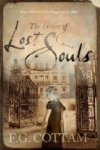The House of Lost Souls
F.G. Cottam
Thomas Dunne Books
Hardcover, 352 pages, $24.99
Review by Sheila Merritt
It requires a bit of magic to effectively concoct an evil edifice. In The House of Lost Souls, author F.G. Cottam does a splendid job of conjuring. He stirs his cauldron of satanic ritual, adds unquiet spirits, and mixes in some nasty non-fiction dabblers in the occult. The result is a creepy and complicated multi-layered novel that demands attention in its vivid depictions of the ghastly and ghostly.
Fischer House has a reputation as a malevolent mansion. In 1995, a group of four female college students cross its threshold. One subsequently commits suicide and the remaining trio is left severely psychologically impaired. The event triggers the need for the experience of Paul Seaton, who in the 1980s, went inside the house and survived its terrors. “Survived” in the sense that he is alive; the mental wounds are profoundly deep; he was institutionalized as a result of his trauma.
As a young journalist, Paul was motivated to investigate the property by his girlfriend. She was writing a paper on 1930s photographer Pandora Gibson-Hoare, but reached a dead end in her research. Paul becomes obsessed with Pandora: She was beautiful, wealthy, talented, and drawn to the dark arts. Dennis Wheatley, writer of supernatural suspense, and the notorious occultist Aleister Crowley were members of her social circle — and coven. The integration of these two real life figures within the story line is extremely well done. It prompts the reader to want to find out more about the duo and their involvement with the uncanny. This rather parallels the protagonist’s fascination with the tragic Pandora; a desire to dig deeper for information.
Paul’s fixation on the photographer leads him to his first horrific exploration of Fischer House. The experience of encountering evil prompts an epiphany: “His perceptions would never be the same and he knew that dread would always follow him now, would be with him like some grave medical condition newly and devastatingly diagnosed. He’d been very ignorant about the world. And already, he felt an intense nostalgia for the bliss of the ignorance he had so recently lost.”
The House of Lost Souls is packed with loads of detail, and thus requires lots of patience in between the chilling, excellent scenes of phantoms and devil worship. There is also an understandable laxity about “facts” in the use of historical figures in the plot. Author Cottam has loosely used the personas of Wheatley and Crowley, and a few other real people, and plays upon their reputations rather than on any depth of character.
This first novel is brilliantly rendered and exquisitely eerie. It won’t work as a quick fix jolt of horror in your face; the story calls for reflection and analysis. There are many layers to the book: It is easy to wonder if Fischer House isn’t a reference to the character Benjamin Fischer from Richard Matheson’s Hell House, or to speculate about the influence Wheatley’s The Devil Rides Out has on the narrative. Intellectually stimulating as it is, the novel also has an emotional poignancy; it recalls lost opportunities, loved ones who pass on, and the knowledge that certain experiences will never allow a return to comfort or safety. F.G. Cottam ties it all together in one scary, thoughtful, and touching novel.









